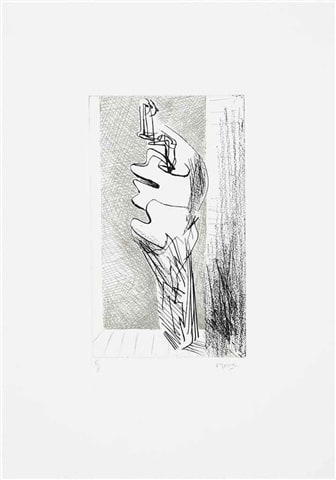Henry Moore British, 1898-1986
-
 Henry MooreEight Sculptural Ideas (Girl Writing), 1973Lithograph in colors on Arches paper26.5 x 30.5"Sold
Henry MooreEight Sculptural Ideas (Girl Writing), 1973Lithograph in colors on Arches paper26.5 x 30.5"Sold -
 Henry MooreGroup of Figures, 1974Lithograph in colors on Rives BFK paper9 x 13"
Henry MooreGroup of Figures, 1974Lithograph in colors on Rives BFK paper9 x 13"
-
 Henry MooreTurning Figure No. 2, 1971Etching in black and grey on Rives paper.9.25 x 5.43"
Henry MooreTurning Figure No. 2, 1971Etching in black and grey on Rives paper.9.25 x 5.43" -
 Henry MooreReclining Figure No. 1, 1970-72Etching and aquatint on Rives paper.4.7 x 9.8"Sold
Henry MooreReclining Figure No. 1, 1970-72Etching and aquatint on Rives paper.4.7 x 9.8"Sold
Henry Moore is perhaps the most influential public sculptor of the twentieth century. Drawing on his studies of Classical, pre-Columbian and African art, Moore created original and truly modern sculptural forms with Abstractions of organic shapes as his primary motif. In addition, Moore is particularly well known for his reclining nudes and the “Mother and Child” series.
Throughout his career, Moore utilized a wide range of techniques and media, such as line drawing and cross-hatching, gouache, chalk and crayon, to bring two-dimensional forms to life, creating impressions of movement and radiance and carving human forms from a sheet of paper in a similar fashion to the way in which he carved expressive forms from slabs of stone. With these works on paper, Moore was not drawing simply as an exercise. Instead, the artist was drawing for ‘the pleasure of looking more intently and intensely’; emphasizing that these works on paper are not simply sketches, but instead illustrates important stages in Moore’s development as a draughtsman and sculptor.
Henry Moore is perhaps the most influential public sculptor of the twentieth century. Drawing on his studies of Classical, pre-Columbian and African art, Moore created original and truly modern sculptural forms with Abstractions of organic shapes as his primary motif. In addition, Moore is particularly well known for his reclining nudes and the “Mother and Child” series.
Throughout his career, Moore utilized a wide range of techniques and media, such as line drawing and cross-hatching, gouache, chalk and crayon, to bring two-dimensional forms to life, creating impressions of movement and radiance and carving human forms from a sheet of paper in a similar fashion to the way in which he carved expressive forms from slabs of stone. With these works on paper, Moore was not drawing simply as an exercise. Instead, the artist was drawing for ‘the pleasure of looking more intently and intensely’; emphasizing that these works on paper are not simply sketches, but instead illustrates important stages in Moore’s development as a draughtsman and sculptor.







